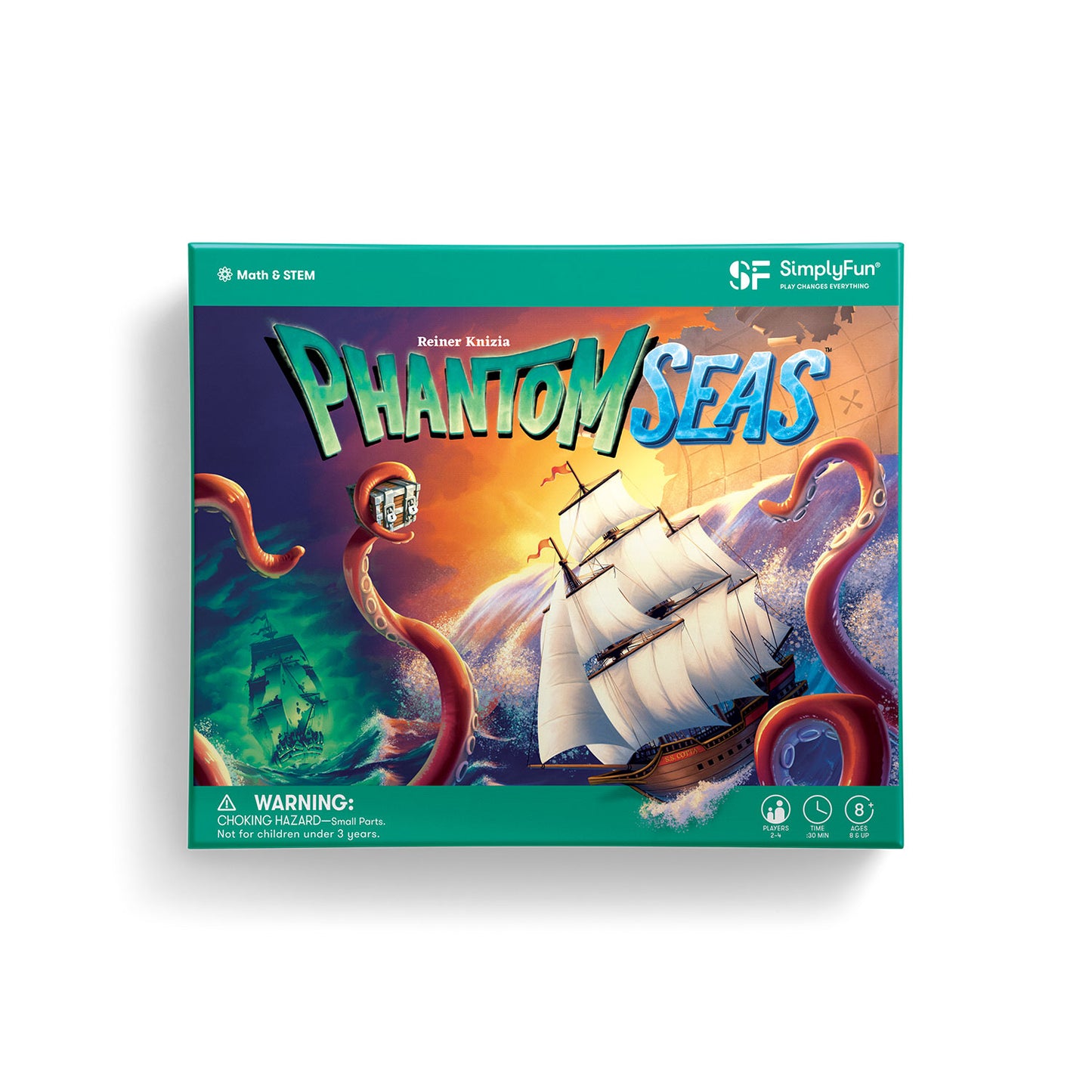
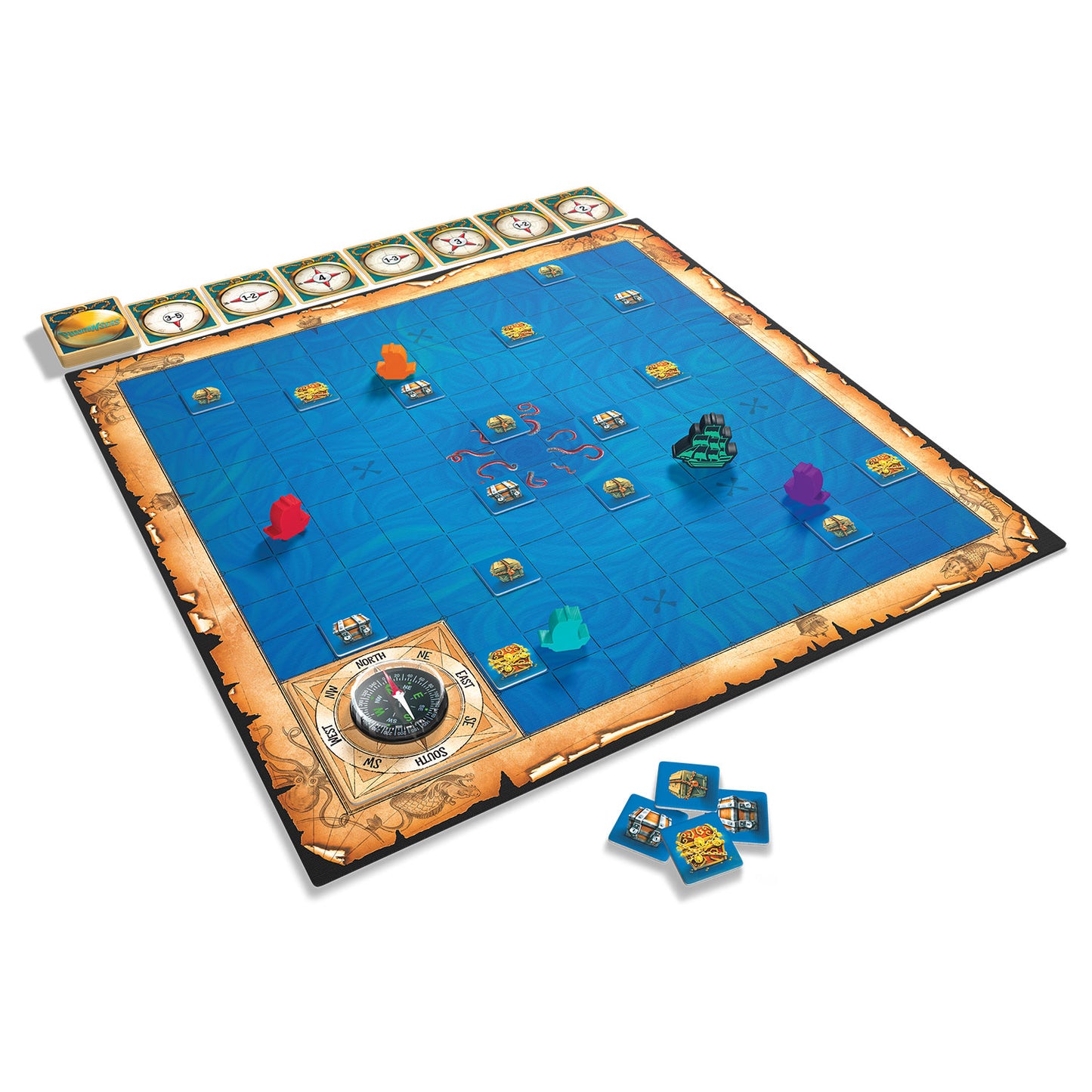
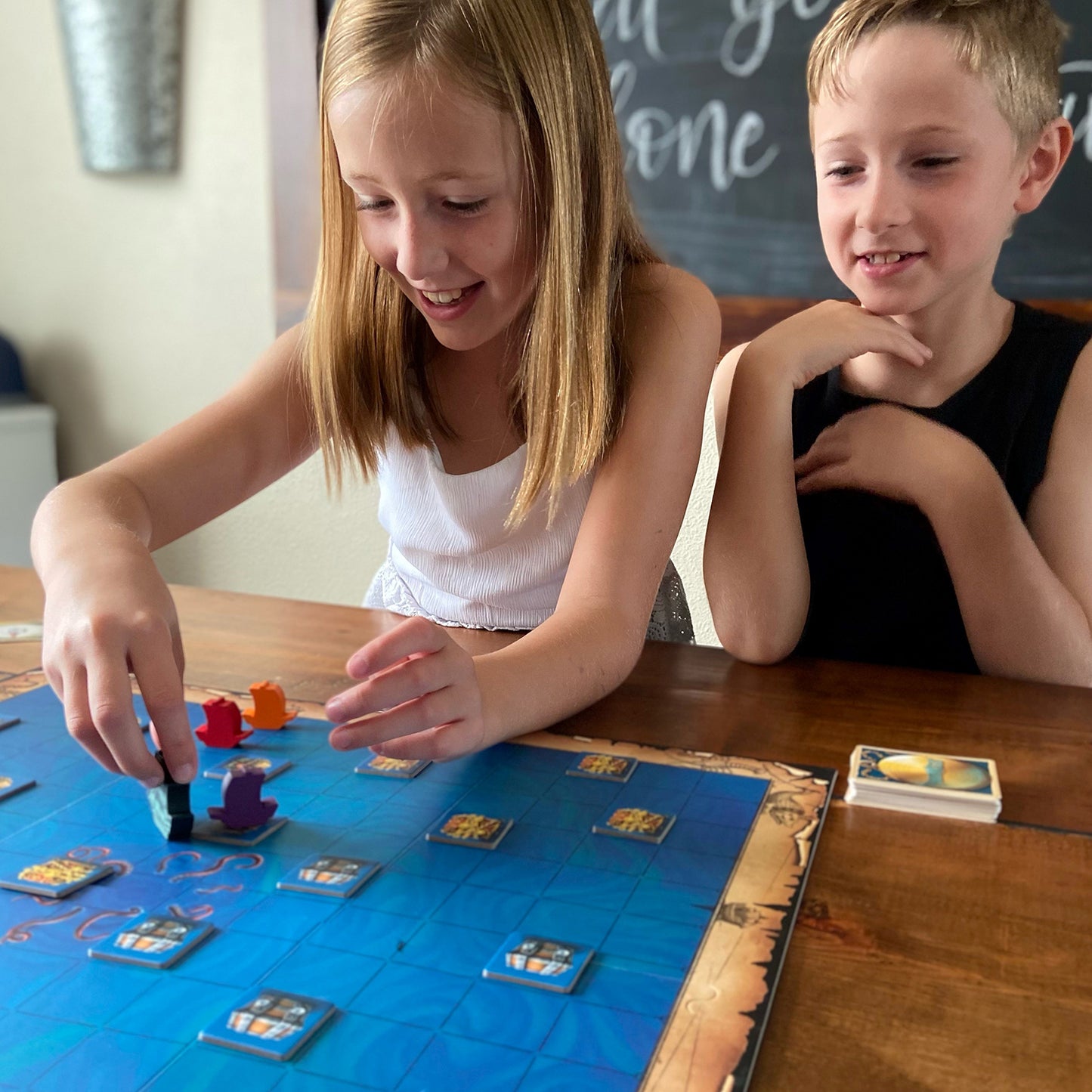
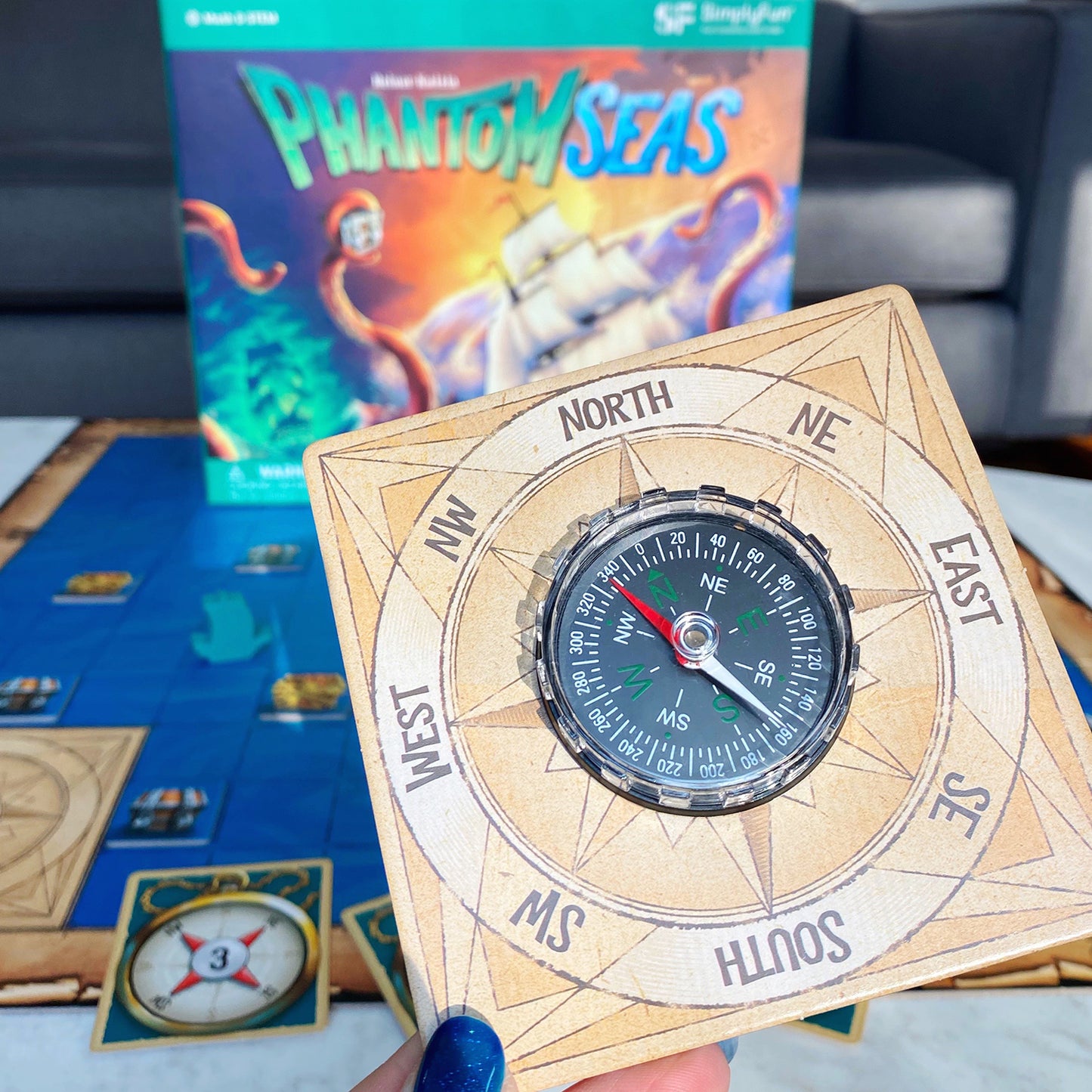
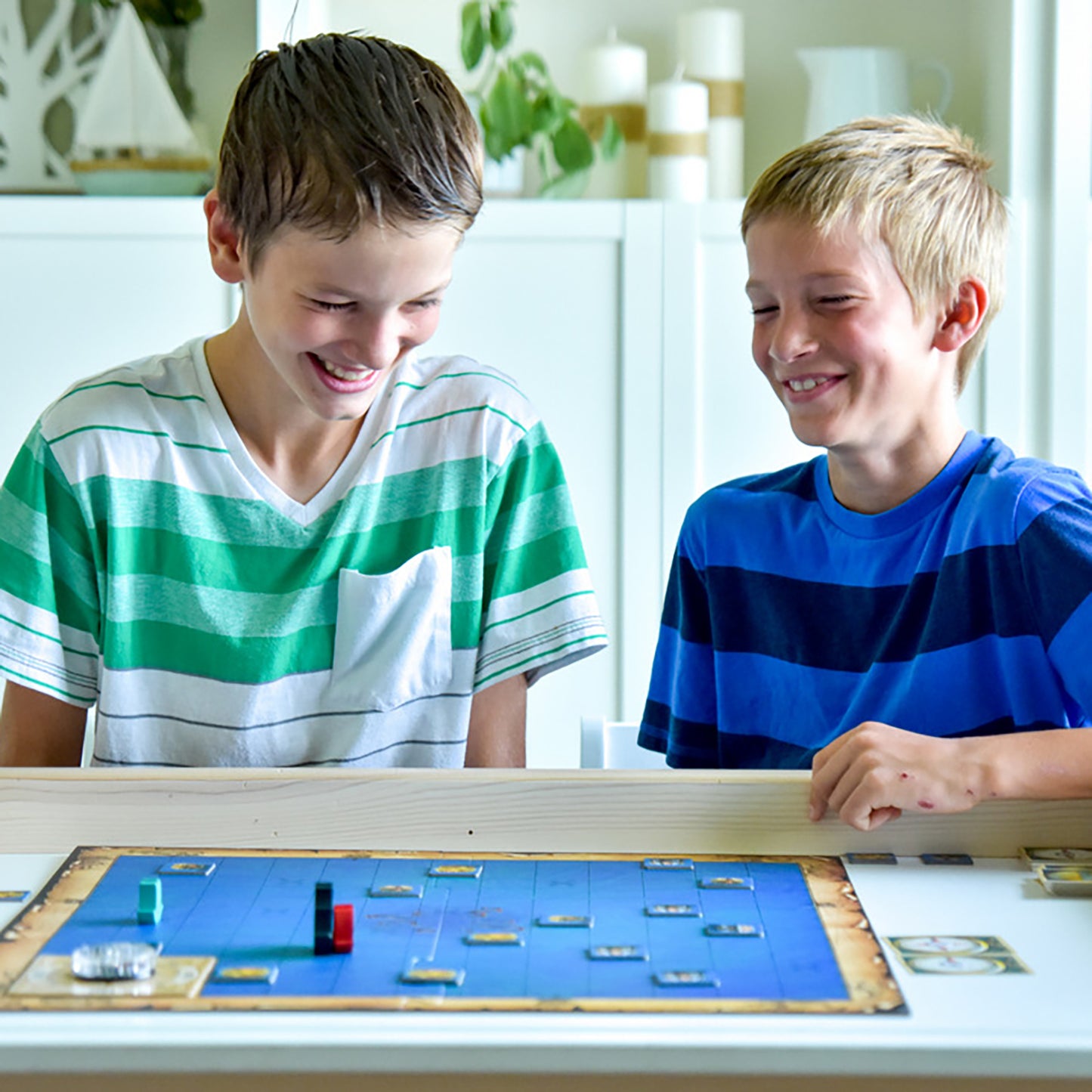

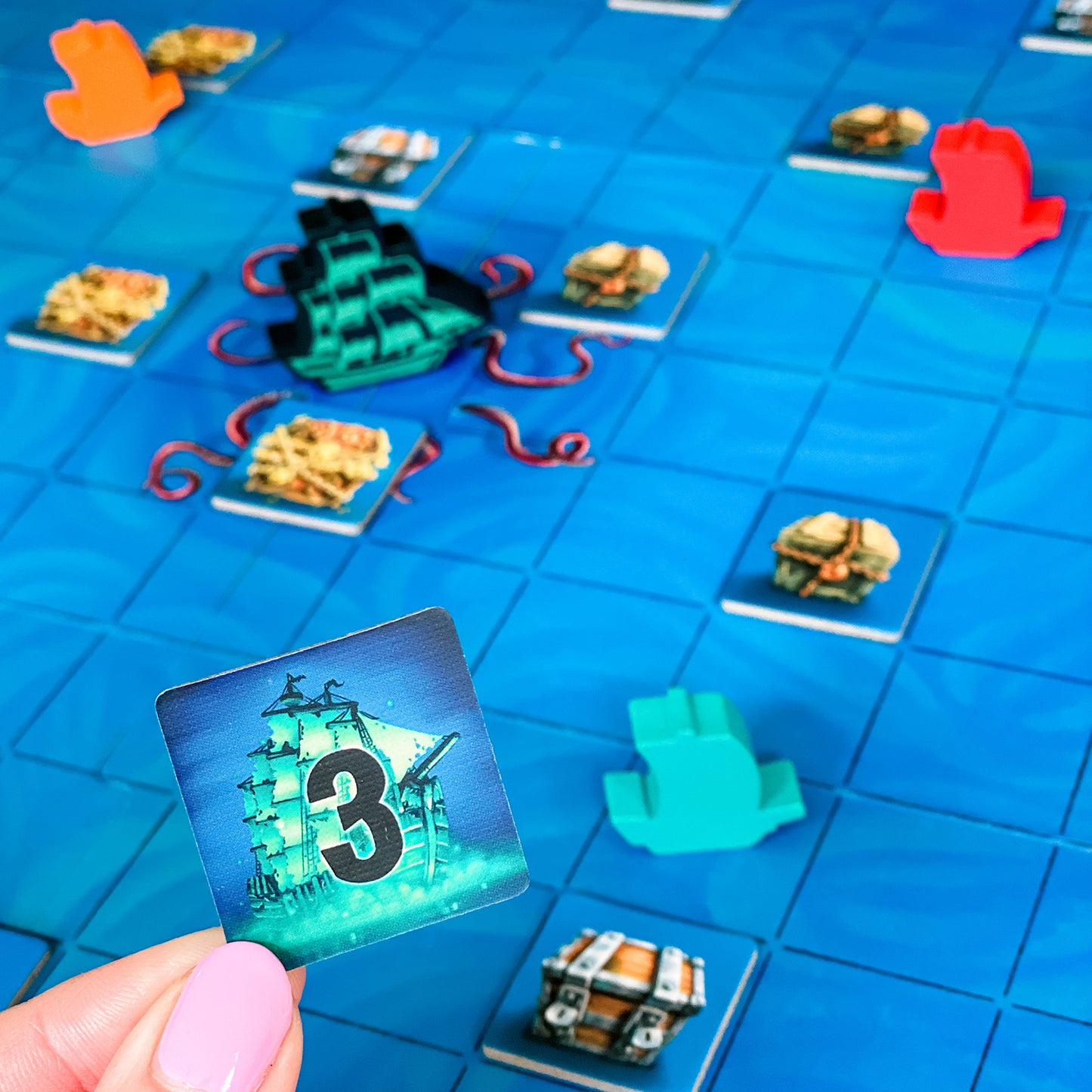
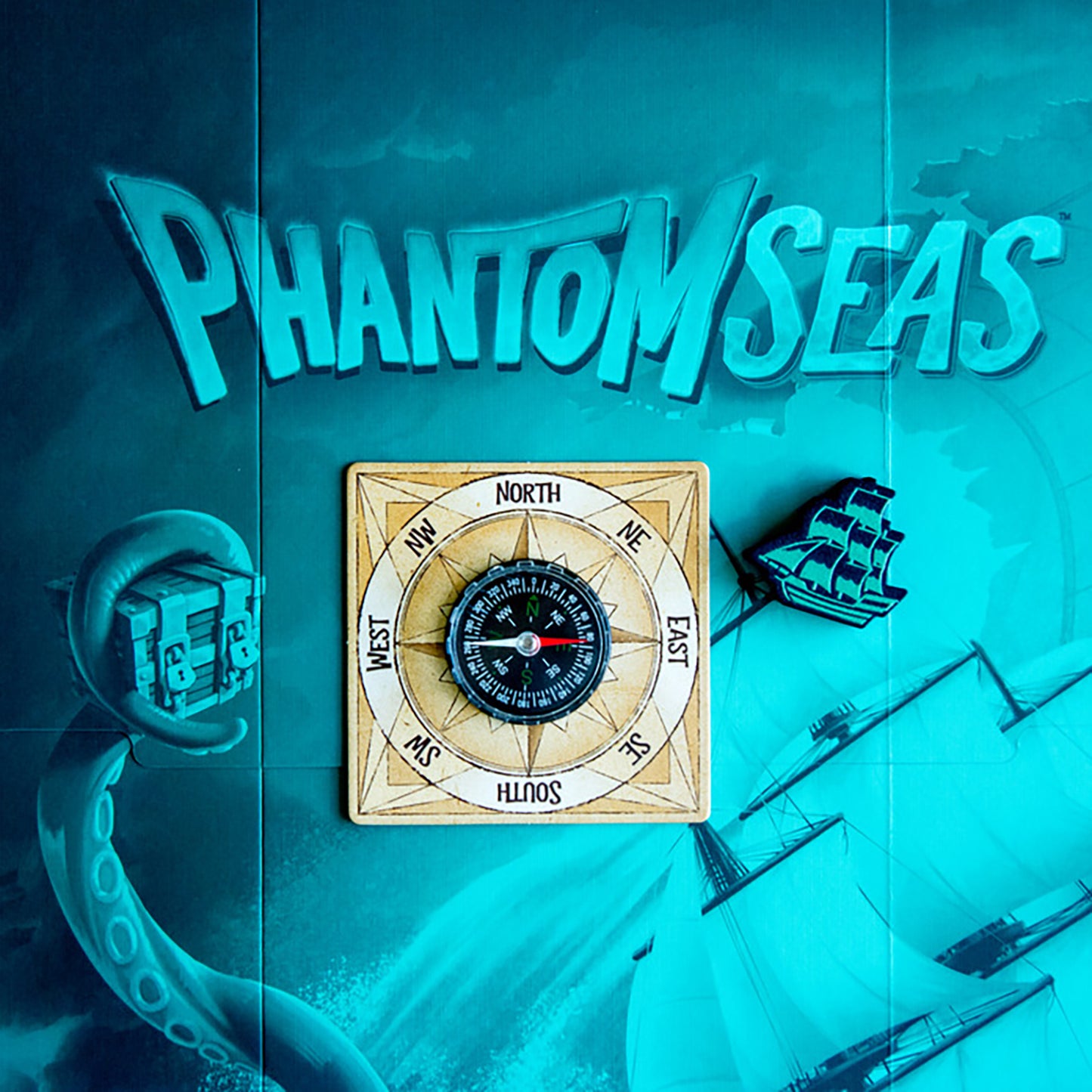
Collapsible content
A game where players use a compass and navigation cards to steer their ships toward sunken treasure sites scattered across the map while trying to avoid the Phantom Ship that may take back their loot.
You can play Phantom Seas with 2-4 players, ages 8 and up.
Phantom Seas is good for developing Directional Awareness Skills as players use a compass and choose Navigation cards to move their pawn in cardinal and intercardinal directions to specific locations on the map.
Phantom Seas also helps with Navigating Skills as players strengthen their understanding of directionality and spatial orientation as they need to reorient and adjust their route when the map is rotated.
Place the gameboard in the center of the play area, where everyone can reach.
Then place the compass in the indicated corner of the map.
Rotate the gameboard until the red side of the needle is pointing exactly north.
Note that nearby magnets and metal parts of the table can affect the compass, so be sure you are at least six inches or more from any metal objects.
Each player chooses one of the four ship pawns and places it on a different starting space, indicated by a picture of a ship next to it, one ship per side of the board.
Mix up the treasure tiles (treasure chest side up) and place them randomly (treasure chest side up), in the spaces marked with an X on the gameboard.
Shuffle the navigation cards and place them facedown as a deck at the north side of the map.
Finally, place the Phantom Ship in the center space of the gameboard.
Players take turns selecting navigation cards with compass instructions to direct their ships toward hidden treasure sites that are scattered across the map while avoiding the Phantom Ship. The player with the largest bounty at the end of the game is the winner.
The game is played over seven rounds. Each round, the starting player reveals seven navigation cards from the deck. Lay the cards in a line along the north side of the map so the tops of the cards all point north.
The first player starts the round, then play continues clockwise.
On your turn, select one of the cards from the line and move your ship pawn accordingly. Then discard the card in the discard pile.
There are several different types of navigation cards:
Single Direction
Allows the player to move in one direction indicated by the needle, choosing one number from the range shown.
Two Directions
Allows the player to choose between one of the two directions shown (east/west or north/south) and Move one or two spaces.
North, South, East, West
Allows the player to choose one of the four compass directions and move the exact number of spaces shown.
And
NE, SE, NW, SW
Allows the player to choose one diagonal direction (northeast, northwest, southeast or southwest), and move the exact number of spaces shown.
Follow the directions on your chosen navigation card to move your ship toward one of the treasure tiles.
Players must move their ship the full distance indicated (or chosen, if a range is shown) on the navigation card
Except:
If your ship pawn would pass the edge of the map, stop on the last space available.
If your ship reaches a space occupied by another ship, you must stop on the space before. Players’ ships cannot move onto or through spaces occupied by other pawns or the Phantom Ship.
If you choose, you may end your turn without moving.
You must still select a card from the line, discard it and say, “Pass.”
If there are no cards left in the line on your turn, you become the starting player for the next round. Reveal seven new navigation cards from the deck to create a new line. Then game play continues.
There are three different types of treasure tiles, each representing a different treasure value.
Gold chest with three locks =3 points
Silver chest with two locks =2 points
Bronze crate with one lock =1 point
In order to collect the treasure, your ship pawn must end its move on a space with a treasure chest. The treasure remains on the board if you move past it.
Collect the treasure by placing it in front of you, then turn the tile over to reveal the event to all players.
Each time you collect and flip over a treasure, the back of the treasure tile will reveal one of two events: Turbulent Waters or Phantom Ship.
Turbulent Waters
Turbulent Waters will disorient you to keep the treasures hidden, causing the whole map to rotate 90 degrees clockwise, while keeping the compass pointing north.
To rotate the board, first turn the compass 90 degrees counterclockwise (or ¼ turn to the left). The needle will point toward the side marked “East.”
Then rotate the gameboard 90 degrees clockwise (¼ turn to the right) until the needle properly points to the side marked “North” again.
Phantom Ship
The Phantom Ship is the guardian of the treasures, and when activated, it will try to reclaim a treasure by moving toward the ship that is trying to salvage the treasure tile.
The number of spaces the Phantom Ship moves is indicated on the back of the treasure tile. First it moves diagonally toward your ship pawn until it reaches the same row or column, then it moves in a straight line.
If the Phantom Ship reaches your ship pawn at any point during its move, it stops there and takes the treasure you just salvaged. This treasure is now discarded to the box.
If the Phantom Ship is unable to reach your ship, it moves as far as possible and remains there until activated again and you get to keep the treasure!
The Phantom Ship only affects the player that has triggered the event by salvaging a treasure chest.
It sails through all other ships, but any occupied spaces should still be counted when moving the Phantom Ship.
The game ends after seven rounds when all the navigation cards have been played or discarded.
Scoring
Each player adds up the total value of all the treasure they have collected. The player with the largest bounty (highest total treasure value) is the winner!
If there is a tie, the tied players add up all the Phantom Ship numbers on the back of their tiles and the player with the highest total wins.
Find your bearings, adjust your course and navigate your ship toward the sunken treasures in the turbulent waters of the Phantom Seas.


Core Standard* Math
Math
- Measurement & Data
- Solve problems involving measurement and estimation of intervals of time, liquid volumes, and masses of objects. Grade Level 3rd


Explore
What Does Child Do To Use Skill In The Game?
Phantom Seas involves a little exploration as players examine the navigation cards to see options for moving their Ship pawn towards treasures on the game board.
How Parents Can Assist Learning
Suggest to children that they pick up the different Navigation cards and hold them over their Ship pawn. This can help children learn directionality and more easily see where their Ship can move.
Learning Implications and Educator Support
Phantom Seas involves spatial reasoning, sequencing and some strategic thinking. It also requires a high degree of adaptability since the entire game board will be rotated several times during the game, which changes every players' perspective and plans for moving their Ships.
Encourage children to take their time to think through all the options prior to deciding what Navigation card to select. The child can even walk around the game board to help see different possibilities. This will help reduce impulsivity and increase their ability to consider the risk-reward of different moves.
Determine
What Does Child Do To Use Skill In The Game?
On each turn of Phantom Seas, players need to decide on which Navigation card to select in order to move their ship towards a treasure or away from the Phantom ship.
How Parents Can Assist Learning
After children make a move, ask them to explain why they decided to select the particular Navigation card. This helps all player learn by hearing what others think and then observe the consequences.
Learning Implications and Educator Support
Phantom Seas involves spatial reasoning, sequencing and some strategic thinking. It also requires a high degree of adaptability since the entire game board will be rotated several times during the game, which changes every players' perspective and plans for moving their Ships.
After children make a move, ask them to explain why they decided to select the particular Navigation card. If needed, ask open-ended questions to help the child think more thoroughly about the consequences of their choice, and how they may consider different options next time.
Compare
What Does Child Do To Use Skill In The Game?
Based on the Navigation cards showing, players need to compare options for moving their ship towards a desired location, which is usually a treasure or away from the Phantom ship.
How Parents Can Assist Learning
Suggest to children that they pick up the different Navigation cards and hold them over their Ship pawn. This can help children more easily see where their Ship can move.
Learning Implications and Educator Support
Phantom Seas involves spatial reasoning, sequencing and some strategic thinking.
Encourage children to take their time to think through all the options prior to deciding what Navigation card to select. The child can even walk around the game board to help see different possibilities. This will help reduce impulsivity and increase their ability to consider the risk-reward of different moves.
Remember
What Does Child Do To Use Skill In The Game?
While not a memory game, players who remember the numbers revealed after Treasure tokens are turned over will have an advantage in assessing risk and reward of future moves.
How Parents Can Assist Learning
If children are able to remember numbers of Treasure tokens, suggest that they just remember the high numbers to start. This will help them assess the risk and reward of trying to land on a particular Treasure tile based on the tiles proximity to the Phantom ship.
For example, if all the 7s and 6s are already turned over, and the Phantom ship is 7 spaces away from a Treasure token, the child can know that the Phantom ship cannot reach the Treasure token when it is turned over.
Learning Implications and Educator Support
Phantom Seas involves light strategic thinking. If children can remember the numbers revealed when Treasure tokens are turned over, this will allow them to play more strategically. In particular, they will be able to assess the risk and reward of trying to land on a particular Treasure tile based on the tiles proximity to the Phantom ship.
For example, if all the 7s and 6s are already turned over, and the Phantom ship is 7 spaces away from a Treasure token, the child can know that the Phantom ship cannot reach the Treasure token when it is turned over.
Predict
What Does Child Do To Use Skill In The Game?
Phantom Seas involves a little predicting as players consider how others may react to their moves, and the probability of a low or high number being revealed under a particular Treasure token.
How Parents Can Assist Learning
Since children cannot see what is under the Treasure tokens, it is difficult to predict accurately. Moreover, the game board will turn several times during the game which typically thwarts plans.
However, as the game goes on, children will notice how others are moving to collect treasures and which numbers under the treasures have been revealed. This information helps to make more accurate predictions of where others are trying to go and when landing on a Treasure token may avoid the Phantom ship.
Learning Implications and Educator Support
Phantom Seas involves risk and reward analysis, some based on chance and others based on strategic thinking that increases as the game progresses. Children will notice how others are moving to collect treasures and which numbers under the treasures have been revealed. This information helps to make more accurate predictions of where others are trying to go and when landing on a Treasure token may avoid the Phantom ship.
Plan
What Does Child Do To Use Skill In The Game?
Players can think about several moves ahead, but the moves of other players and the rotation of the game board means that typically Phantom Seas does not involve planning.
How Parents Can Assist Learning
Encourage children to look for multiple move options so that they can pick the best one on their turn, while considering the prior moves of others.
Learning Implications and Educator Support
Encourage children to look for multiple move options so that they can pick the best one on their turn, while considering the prior moves of others.
Practice
What Does Child Do To Use Skill In The Game?
Phantom Seas is good game for learning directionality and basic navigation.
How Parents Can Assist Learning
No special parent support required.
Learning Implications and Educator Support
Educators may want to incorporate Phantom Seas into classroom or in home discussions regarding geography, globes, maps, and the use of compasses to determine location and directionality.
Solve
What Does Child Do To Use Skill In The Game?
Players adapt to the moves of other players and Phantom ship in order to pick Navigation cards they help them move towards treasures.
How Parents Can Assist Learning
Parents can ask questions like "What treasures do you think the other players are trying to get?" or "How likely would it be for the Phantom ship to catch you if you move to that Treasure token?" Questions like these can help children think carefully to select the best option based on all the information available to them on their turn.
Learning Implications and Educator Support
Phantom Seas is a good game for teaching adaptability, perspective changing and spatial reasoning as children adjust their targeted Treasure tokens based on the rotation of the game board and movements of other ships.
*Data compiled from CCSSI ELA Standards, WA Science Standards, and Washington Social Studies Standards


Cognitive
Suggestions for How to Modify Play Experience
Children with cognitive challenges may benefit from playing with a partner. The partner can then help the child learn the symbols on the compass and Navigation cards, and what those mean in terms of directionality. They can practice by turning their bodies in the different directions depicted on the compass.
Communication
Suggestions for How to Modify Play Experience
Communication can be encouraged by commenting on the Navigation cards (e.g., "Tell me what direction you want to go. How are you going to decide which cards to choose?").
Use open-ended questions to encourage talk.
Sensorimotor
Suggestions for How to Modify Play Experience
The squares on the board are fairly large and the ship Pawns are easy to hold. Fine motor problems should not be an issue. If the Pawns are too small, substitute a small toy ship that is easier to hold.
Social Emotional/Behavioral
Suggestions for How to Modify Play Experience
For children who are easily frustrated or overwhelmed, have them play with a partner. This enables them to work together to make decisions.
Vision
Suggestions for How to Modify Play Experience
Some of the treasure chests may be difficult to see against the blue ocean background. Use a bright neon highlighter to outline each of the Treasure Tiles so they are more easily visible.
Hearing
Suggestions for How to Modify Play Experience
Hearing should not be an issue in playing the game. To enjoy the social interaction, players may want to learn some simple signs (e.g., "Good for you!" "Bad!" "Oh, No!")
*Data compiled from CCSSI ELA Standards, WA Science Standards, and Washington Social Studies Standards


Autism Strengths & Interests
Short Summary of Strengths & Interests
- Spatial Reasoning
- Directionality
- Reasoning
Is good at matching visual items
Is This Game Appropriate? Yes
Description
Players need to match the compass pictures on the Navigation cards to the location of their Ship Pawn in relation to the treasures on the board. This is not a direct match, but a more abstract match of directionality.
Has a good memory for sensory details, including visual, touch, taste and smell
This game is not appropriate
Has a good memory for words, phrases and dialouge
This game is not appropriate
Has a good memory for pictures, numbers and patterns
This game is not appropriate
Likes to put things in order or a sequence
Is This Game Appropriate? Yes
Description
Players need to use the compass pictures on the Navigation cards to determine the best card to choose to move their Ship Pawn towards the treasures on the board. Players have to sequence their moves in the right direction and order to get as close to their Treasure as they can in their turn.
Learns through visualizing or "replaying" actions in their mind
Is This Game Appropriate? Yes
Description
Transferring the options seen on the Navigation Cards to the board requires mentally visualizing the options on each card to moves on the board. Visualizing enables players to select the best option.
Likes activities with rules, such as math and phonics
Is This Game Appropriate? Yes
Description
Phantom Seas requires understanding the rules related to compass use and navigation.
Is very concrete and literal
Is This Game Appropriate? Yes
Description
Transfer of the meaning of the Navigation Cards to the board is an abstract task, but movement of the Ship Pawns is concrete.
Learns in small "chunks" (for example, phone numbers are 3 chunks of number xxx-xxx-xxxx that are combined together)
This game is not appropriate
Is good at nonverbal reasoning and logic
Is This Game Appropriate? Yes
Description
Phantom Seas is a game requiring nonverbal reasoning. Players determine the best Navigation Card to choose based on their analysis of the position of their Ship Pawn in relation to the various Treasure tiles.
Likes spatial problem solving
Is This Game Appropriate? Yes
Description
This games involves significant spatial reasoning and understanding. Uniquely, the spatial problem-solving and directional reasoning in Phantom Seas enable players to learn basic navigation skills.
Can read well with good vocabulary, though may not fully comprehend content
Is This Game Appropriate? Yes
Description
Reading is not required. The directions can be demonstrated.
Likes to use and has good fine motor skill
Is This Game Appropriate? Yes
Description
Fine motor skills are needed to manipulate the Ship Pawn around the board, but precise skills are not needed.
Likes established routines or set ways of doing things
Is This Game Appropriate? Yes
Description
Each play follows the same sequence, but players need to be flexible to adjust to the movements of the Phantom Ship and the other players' Ship pawns.
Likes manipulating, constructing or building things
This game is not appropriate
Likes to use and has good musical abilities
This game is not appropriate
Likes to use and has good drawing skills
This game is not appropriate
Autism Special Considerations
Appears to ignore other's communication and/or has difficulty giving eye contact to a communication partner
Is This Game Appropriate for Child with Characteristic? Yes
Can Child with Characteristic Play Game w/o Modification? Yes
Strategies for Developing Compensatory Skills:
Players of Phantom Seas do not need to give eye contact, but they do need to watch the plays on the game board to be able to plan their moves.
Has difficulty understanding complex verbal directions
Is This Game Appropriate for Child with Characteristic? Yes
Can Child with Characteristic Play Game w/o Modification? No
Strategies for Developing Compensatory Skills:
The directions to Phantom Seas are somewhat complex, but other players can demonstrate game play and prompt actions as needed.
Uses vocabulary inaccurately or demonstrates echolalia (repeating another's speech)
Is This Game Appropriate for Child with Characteristic? Yes
Can Child with Characteristic Play Game w/o Modification? Yes
Strategies for Developing Compensatory Skills:
If the child' s echolalia does not interfere with other players' ability to concentrate on the game, this should not be a problem. A fidget toy that they child likes may help reduce echolalia.
Gets stuck repeating a verbal topic or physical actions and/or has difficulty attending to others' actions or topic.
Is This Game Appropriate for Child with Characteristic? No
Can Child with Characteristic Play Game w/o Modification? Yes
Strategies for Developing Compensatory Skills:
The child's comments may not interrupt the game, but if the child's talk and actions inhibit his attention to the game, he will not be able to fully participate. Other players may be able to redirect the child's attention back to the game play.
Has difficulty producing speech/communication
Is This Game Appropriate for Child with Characteristic? Yes
Can Child with Characteristic Play Game w/o Modification? Yes
Strategies for Developing Compensatory Skills:
Communication is not needed to play Phantom Seas, but communication about the various plays should be encouraged.
Has difficulty sequencing multi-step actions and/or doing complex abstract tasks
Is This Game Appropriate for Child with Characteristic? No
Can Child with Characteristic Play Game w/o Modification? Yes
Strategies for Developing Compensatory Skills:
Phantom Seas requires sequencing several steps in each turn. One of the steps requires players to translate options seen on Navigation Cards to moves on the board. This requires abstract thinking and mental visualization of Ship Pawn moves on the board. One option is to allow the child with autism to "play out" the various actions on the Navigation Cards, with support from other players. This will make the actions on the cards more concrete and help the child determine a course of action.
Demonstrates difficulty initiating and maintaining social interactions
Is This Game Appropriate for Child with Characteristic? Yes
Can Child with Characteristic Play Game w/o Modification? Yes
Strategies for Developing Compensatory Skills:
If the child is interested in and motivated to acquire the treasures, the child can play without social interaction. Social interaction can be encouraged through other players commenting and asking questions about the child's plays. They can also aks the child for advise on their own moves to encourage more involvement.
Acts out or demonstrates avoidance behaviors when frustrated, overwhelmed, or needs more sensory input.
Is This Game Appropriate for Child with Characteristic? Yes
Can Child with Characteristic Play Game w/o Modification? No
Strategies for Developing Compensatory Skills:
The child who gets easily frustrated or overwhelmed may need to use a fidget toy, take a break, or be supported with deep pressure, slow breathing, or other strategies that work for the child.
Has short attention span for non-preferred activities
Is This Game Appropriate for Child with Characteristic? No
Can Child with Characteristic Play Game w/o Modification? Yes
Strategies for Developing Compensatory Skills:
Phantom Seas is a good match for children who have an interest in spatial problem solving, compasses, and/or ships. Children who are not interested in these areas may not have as much fun with the game.
Needs sameness or consistent routines and/or has difficulty with transitions from one activity to another
Is This Game Appropriate for Child with Characteristic? No
Can Child with Characteristic Play Game w/o Modification? No
Strategies for Developing Compensatory Skills:
Although the game follows the same pattern with each play, there will be twists and turns, when the board shifts, when the Phantom Ship captures your treasure, when you don't have a viable option for moving your Ship Pawn. Children who have difficulty with these unexpected events might find Phantom Seas challenging.
Has difficulty understanding others' feelings, intentions, and the reasons for others' actions.
Is This Game Appropriate for Child with Characteristic? Yes
Can Child with Characteristic Play Game w/o Modification? Yes
Strategies for Developing Compensatory Skills:
Players don't have to understand other players' thoughts or feelings to play the game; although, it is helpful to watch other players' movements and anticipate what treasure they are trying to get.
*Data compiled from CCSSI ELA Standards, WA Science Standards, and Washington Social Studies Standards


Extra Ways to Play the Game
To make the game more challenging, reduce the number of Navigation tiles to 4 and eliminate option of passing.
Materials Needed
No additional materials needed.
Developmental Benefits
This modification forces players to make a decision in play among limited options. This means they may need to go in a different direction than they desire. They will need to use a more complex navigation strategy to reach the desired higher value treasure chests.
Extra Ways to Play the Game
To add additional strategy, allow players to rotate the board either clockwise or counterclockwise if they turn over a Turbulent Waters treasure tile.
Materials Needed
No additional materials are needed.
Developmental Benefits
The original directions add an element of chance with the Turbulent Waters feature. With this modification, the game still retains the unpredictability while now providing the player who turns over the Turbulent Waters tile the opportunity to analyze and assess whether it would be more beneficial for them to rotate that board to the left or the right.
*Data compiled from CCSSI ELA Standards, WA Science Standards, and Washington Social Studies Standards
- Choosing a selection results in a full page refresh.
- Opens in a new window.









